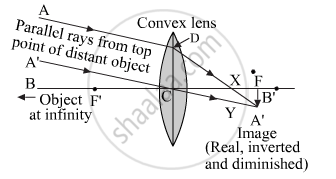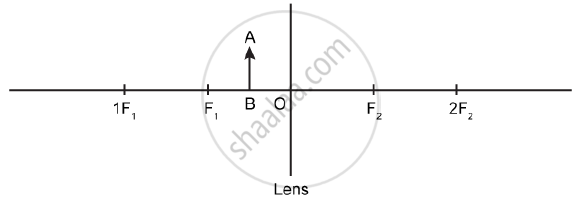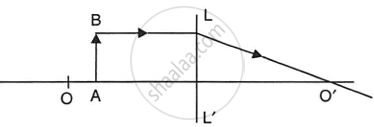Advertisements
Advertisements
प्रश्न
Describe with the help of a ray diagram the nature, size and position of the image formed when an object is placed at infinity (considerable distance) in front of a convex lens. State three characteristics of the image so formed.
उत्तर
Image formation diagram:

Image characteristics:
(1)Image – at F
(2)Nature of image – real and inverted
(3)Size of Image – point sized
APPEARS IN
संबंधित प्रश्न
A student wants to project the image of a candle flame on the walls of school laboratory by using a lens:-
(a) Which type of lens should be use and why?
(b) At what distance in terms of focal length 'F' of the lens should be place the candle flame so as to get (i) a magnified, and (ii) a diminished image respectively on the wall?
(c) Draw ray diagram to show the formation of the image in each case?
One-half of a convex lens is covered with a black paper. Will this lens produce a complete image of the object? Verify your answer experimentally. Explain your observations.
An object AB is placed between O and F1 on the principal axis of a converging lens as shown in the diagram.

Copy the diagram and by using three standard rays starting from point A, obtain an image of the object AB.
List some things that convex lens and concave mirror have in common.
A convex lens has a focal length of 10 cm. At which of the following position should an object be placed so that this convex lens may act as a magnifying glass?
(a) 15 cm
(b) 7 cm
(c) 20 cm
(d) 25 cm
Find the position and nature of the image of an object 5 cm high and 10 cm in front of a convex lens of focal length 6 cm.
Study the diagram given below.

- Name the lens LL’.
- What are the points O and O’ called?
- Complete the diagram to form the image of the object AB.
- State the three characteristics of the image.
- Name a device in which this action of lens is used.
State the position of object, position of image, nature of image when: Convex lens is used as in searchlight.

The above image shows a thin lens with a focal length of 5m.
- What is the kind of lens shown in the above figure?
- If a real inverted image is to be formed by this lens at a distance of 7m from the optical centre, then show with calculation where should the object be placed.
- Draw a neatly labelled diagram of the image formation mentioned in (ii).
Distinguish between:
Concave lens and Convex lens
